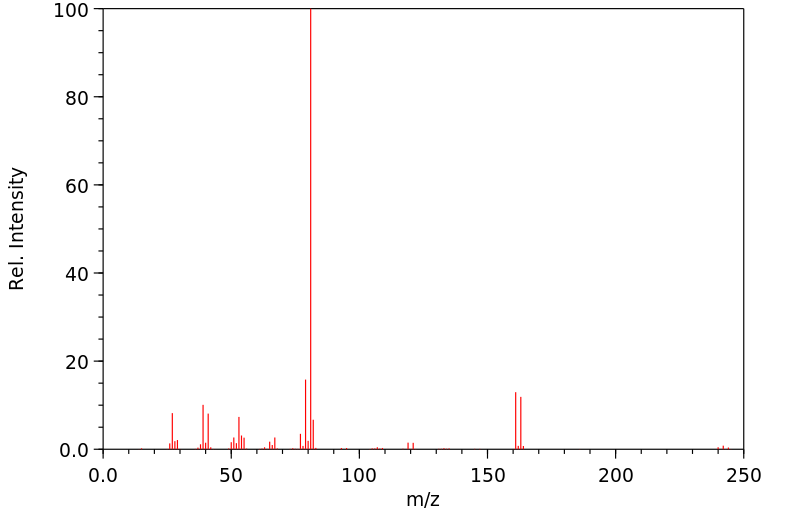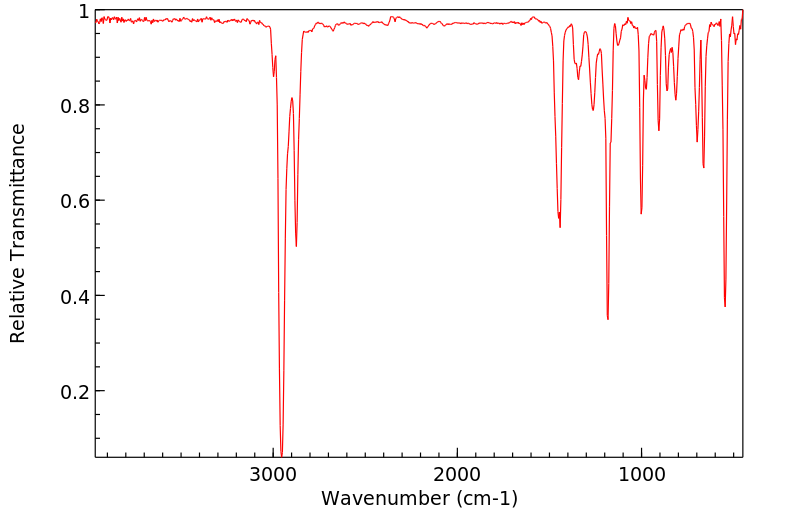(+)-(S,S)-trans-1,2-dibromocyclohexane | 53023-22-6
中文名称
——
中文别名
——
英文名称
(+)-(S,S)-trans-1,2-dibromocyclohexane
英文别名
trans-1,2-dibromocyclohexane;(1S)-trans-1,2-dibromo-cyclohexane;Trans-1,2-dibrom-cyclohexan;trans-1.2-Dibromocyclohexan;trans-1,2-Dibromcyclohexan;trans-Dibromocyclohexan;Cyclohexane,1,2-dibromo-,trans-;(1S,2S)-1,2-dibromocyclohexane
CAS
53023-22-6
化学式
C6H10Br2
mdl
——
分子量
241.953
InChiKey
CZNHKZKWKJNOTE-WDSKDSINSA-N
BEILSTEIN
——
EINECS
——
-
物化性质
-
计算性质
-
ADMET
-
安全信息
-
SDS
-
制备方法与用途
-
上下游信息
-
文献信息
-
表征谱图
-
同类化合物
-
相关功能分类
-
相关结构分类
物化性质
-
沸点:220.5±15.0 °C(Predicted)
-
密度:1.789±0.06 g/cm3(Predicted)
计算性质
-
辛醇/水分配系数(LogP):3.1
-
重原子数:8
-
可旋转键数:0
-
环数:1.0
-
sp3杂化的碳原子比例:1.0
-
拓扑面积:0
-
氢给体数:0
-
氢受体数:0
上下游信息
-
上游原料
中文名称 英文名称 CAS号 化学式 分子量 —— trans-1,2-dibromocyclohexane 7429-37-0 C6H10Br2 241.953
反应信息
-
作为产物:参考文献:名称:Fluorous triphase and other multiphase systems摘要:将第一种非氟化合物反应以产生第二种非氟化合物的方法包括以下步骤:将包括第一种非氟化合物的第一种非氟相与第一氟相在第一相界面接触,第一种非氟化合物在第一氟相和第一非氟相之间分布;将第一氟相与第二种非氟相在第二相界面接触;在第二种非氟相中至少包括一个与第一种非氟化合物反应以产生第二种非氟化合物的第三种非氟化合物,第二种非氟化合物的分配系数小于第一种非氟化合物。例如,第一种非氟化合物可以是二溴或二碘,第二种非氟化合物可以是烯烃。公开号:US06897331B2
文献信息
-
Catalytic oxidation of C-H bonds申请人:——公开号:US20040087820A1公开(公告)日:2004-05-06The invention provides a catalytic, chemospecific and stereospecific method of oxidizing a wide variety of substrates without unwanted side reactions. Essentially, the method of the instant invention, under relatively mild reaction conditions, catalytically, stereospecifically and chemospecifically inserts oxygen into a hydrocarbon C—H bond. Oxidation (oxygen insertion) at a tertiary C—H bond to form an alcohol (and in some cases a hemiacetal) at the tertiary carbon is favored. The stereochemistry of an oxidized tertiary carbon is preserved. Ketones are formed by oxidizing a secondary C—H bond and ring-cleaved diones are formed by oxidizing cis tertiary CH bonds.
-
A Comparative Study on the Reactivity of Electrogenerated Bromine with Cyclohexene in Acetonitrile and the Room Temperature Ionic Liquid, 1-Butyl-3-methylimidazolium Bis[(trifluoromethyl)sulfonyl]imide作者:Gary D. Allen、Marisa C. Buzzeo、Ieuan G. Davies、Constanza Villagrán、Christopher Hardacre、Richard G. ComptonDOI:10.1021/jp040400z日期:2004.10.1The reactivity of electrogenerated bromine with cyclohexene has been studied on a platinum microelectrode by linear sweep and cyclic voltammetry in both the room temperature ionic liquid, 1-butyl-3-methylimidazolium bis[(trifluoromethyl)sulfonyl]imide, and the conventional aprotic solvent, acetonitrile. Variation in the voltammetric response was observed in the two solvents, indicating that the bromination
-
Novel antibacterial agents申请人:Christensen G. Burton公开号:US20070134729A1公开(公告)日:2007-06-14This invention relates to novel multibinding compounds (agents) that are antibacterial agents. The multibinding compounds of the invention comprise from 2-10 ligands covalently connected by a linker or linkers, wherein each of said ligands in their monovalent (i.e., unlinked) state have the ability to bind to a an enzyme involved in cell wall biosynthesis and metabolism, a precursor used in the synthesis of the bacterial cell wall and/or the bacterial cell surface thereby interfere with the synthesis and/or metabolism of the cell wall. In particular the multibinding compounds of the invention comprise from 2-10 ligands covalently connected by a linker or linkers, wherein each of said ligands has a ligand domain capable of binding to penicillin binding proteins, a transpeptidase enzyme, a substrate of a transpeptidase enzyme, a beta-lactamase enzyme, pencillinase enzyme, cephalosporinase enzyme, a transglycoslase enzyme, or a transglycosylase enzyme substrate; Preferably, the ligands are selected from the beta lactam or glycopeptide class of antibacterial agents.
-
Beta2-Adrenergic Receptor Agonists申请人:Moran Edmund J.公开号:US20080269344A1公开(公告)日:2008-10-30Disclosed are multibinding compounds which are β2 adrenergic receptor agonists and are useful in the treatment and prevention of respiratory diseases such as asthma, bronchitis. They are also useful in the treatment of nervous system injury and premature labor.本发明涉及多结合化合物,其是β2肾上腺素能受体激动剂,可用于治疗和预防哮喘、支气管炎等呼吸系统疾病。它们还可用于治疗神经系统损伤和早产。
-
Beta2-adrenergic receptor agonists申请人:Moran J. Edmund公开号:US20070179179A1公开(公告)日:2007-08-02Disclosed are multibinding compounds which are β2 adrenergic receptor agonists and are useful in the treatment and prevention of respiratory diseases such as asthma, bronchitis. They are also useful in the treatment of nervous system injury and premature labor.本发明涉及多重结合化合物,其为β2肾上腺素能受体激动剂,可用于治疗和预防哮喘、支气管炎等呼吸系统疾病。它们还可用于治疗神经系统损伤和早产。
表征谱图
-
氢谱1HNMR
-
质谱MS
-
碳谱13CNMR
-
红外IR
-
拉曼Raman
-
峰位数据
-
峰位匹配
-
表征信息
同类化合物
顺式-2-氯环己基高氯酸盐
顺式-1-溴-2-氟-环己烷
顺式-1-叔丁基-4-氯环己烷
顺式-1,2-二氯环己烷
顺-1H,4H-十二氟环庚烷
镓,三(三氟甲基)-
镁二(1,1,2,2,3,3,4,4,5,5,6,6,7,7,8,8,8-十七氟-1-辛烷磺酸酯)
铵2,2,3,3,4,4,5,5,6,6,7,7,8,8,9,9,10,10,11,11,12,12,12-二十三氟十二烷酸盐
铜N-(2-氨基乙基)乙烷-1,2-二胺2-氰基胍二氯化盐酸
钾{[(十七氟辛基)磺酰基](甲基)氨基}乙酸酯
钠3-[(3-{[(十七氟辛基)磺酰基]氨基}丙基)(甲基)氨基]-1-丙烷磺酸酯
重氮基烯,(1-溴环己基)(1,1-二甲基乙基)-,1-氧化
辛酸,十五氟-,2-(1-羰基辛基)酰肼
赖氨酰-精氨酰-精氨酰-苯基丙氨酰-赖氨酰-赖氨酸
诱蝇羧酯B1
诱蝇羧酯
萘并[2,1-b]噻吩-1(2H)-酮
膦基硫杂酰胺,P,P-二(三氟甲基)-
脲,N-(4,5-二甲基-4H-吡唑-3-基)-
肼,(3-环戊基丙基)-,盐酸(1:1)
组织蛋白酶R
磷亚胺三氯化,(三氯甲基)-
碳标记全氟辛酸
碘甲烷与1-氮杂双环(4.2.0)辛烷高聚合物的化合物
碘甲烷-d2
碘甲烷-d1
碘甲烷-13C,d3
碘甲烷
碘环己烷
碘仿-d
碘仿
碘乙烷-D1
碘[三(三氟甲基)]锗烷
硫氰酸三氯甲基酯
甲烷,三氯氟-,水合物
甲次磺酰胺,N,N-二乙基-1,1,1-三氟-
甲次磺酰氯,氯二[(三氟甲基)硫代]-
甲基碘-12C
甲基溴-D1
甲基十一氟环己烷
甲基丙烯酸正乙基全氟辛烷磺
甲基三(三氟甲基)锗烷
甲基[二(三氟甲基)]磷烷
甲基1-氟环己甲酸酯
环戊-1-烯-1-基全氟丁烷-1-磺酸酯
环己烷甲酸4,4-二氟-1-羟基乙酯
环己烷,1-氟-2-碘-1-甲基-,(1R,2R)-rel-
环己基五氟丙烷酸酯
环己基(1-氟环己基)甲酮
烯丙基十七氟壬酸酯








